In general our people are suckers for two things. War stories and pretty pictures. 1917 has them both. Both affections are understandable. My study argues that we are understood in REM as the Aryan God Mars, in contrast to the Semitic Mercury, Vulcan and Bacchus. Esoterically we are also understood as Apollo and Venus, Gods of Beauty.
In Jewish myth we are also understood as Japheth, the ancestor of the Europeans. The name Japheth itself means “beauty” and is used to describe beautiful women in the Hebrew Bible that we suspect also of being Aryan, perhaps Rachel and Sarah most saliently.
We are also, perhaps as humans, attracted to tragedy and the film 1917 contains that. Emotive thoughts of death (and failure) appear to us as “profound” because they stir personal fears. There is no question that death is a profound subject but evoking it, and the emotions and fears it inspires, becomes an easy trick in the hands of a dramatist to put us in a vulnerable and suggestible state.
It’s correct to venerate beauty (though in truth there are also many unpleasant and ugly images of war carnage in this film). However commonly Aryans are trusting, wholly oblivious to sub-textual messages that may be smuggled in by an otherwise attractive packaging. The Semitic Prometheus deceived Jupiter likewise, presenting him with a meat offering, succulent and glistening on the outside but rotten inside. When Jupiter discovered the treachery, Prometheus was, famously, punished. Prometheus is not /our guy/.
1917 appears to contain JEM. In fact it appears to contain a specific praise of the Scofield Bible as embodied symbolically in the solider William “Will” Schofield. The director and co-screenwriter, Sam Mendes, is of Jewish ancestry, so this would fit an important pattern detailed in my work.

Briefly, the film focuses on two British soldiers, Tom Blake and William “Will” Schofield, a pair of English soldiers tasked with hand-delivering a message to the Second Battalion of the Devonshire Regiment so as to call off a planned attack against a German position. The Second Battalion lacks critical intel indicating the planned attack is against a heavily fortified position and will result in a massacre. The German’s have cut the communication lines so hand delivery of the command becomes necessary.
One of the soldiers in the Second Battalion is Tom Blake’s brother, Joe Blake. En route, Tom Blake is stabbed to death by an inexplicably malevolent German pilot after rescuing the latter from the burning hulk of a fighter plane. This is perhaps the most salient clue that a racial/political agenda is afoot. Will promises a dying Tom he’ll make the rest of the trip to save Tom’s brother Joe and to deliver sad tidings of Tom’s death. This becomes Will’s driving impetus.
As is commonly the case with JEM, names are of central importance. The name Blake appears to be the perfect one for the messaging of this film, as it may mean “black” or “white.” In JEM naming convention “black” becomes a Jewish identifier. It appears to be a reference to the identity of Yahweh as “black” or swarthy. In the Song of Solomon, we find the figure, always presumed by Jews and Christians to be Yahweh, declaring to his fair (Japheth) lover that he is “black.” [1]
The color white, on the other hand, becomes, as a symbol, a reference to Aryans. Genesis 30 gives us Laban, owner of the white sheep that the proto-Jew Jacob darkens and steals through deception. This includes Laban’s “Japheth” daughter Rachel. Indeed, her name means “ewe” or “baby sheep.” The name Laban means “white.” These are all topics covered in detail in my broader study.
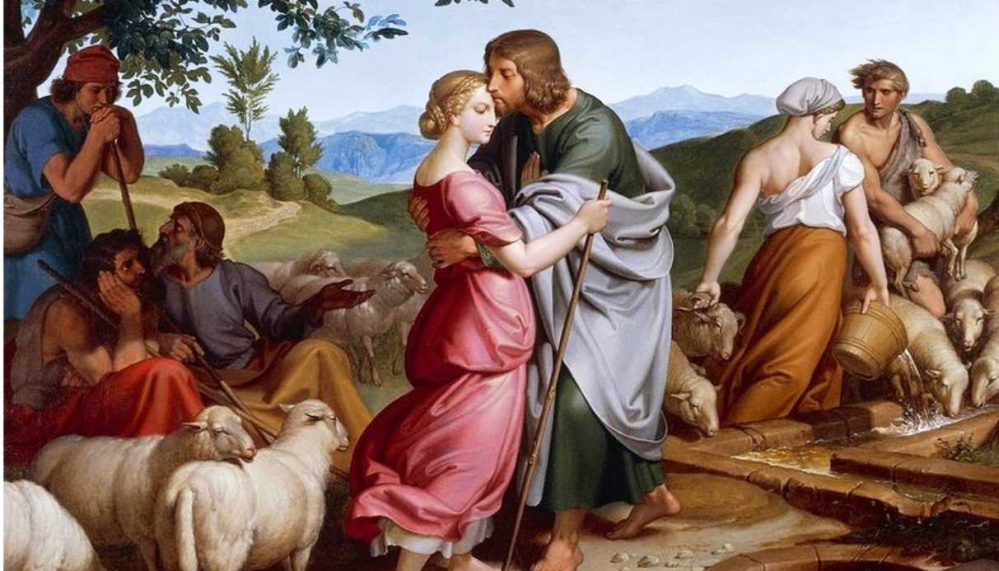
Why is such an ambivalent name like Blake perfect in this context? Tom Blake, I argue, is indicated a Jew, while his older brother Joe, an Aryan. How is this possible? Well it conforms to a reoccurring trope in Jewish Art and Religion where the firstborn is understood as the Aryan and the second born the Jew, proto-Jew or Semite. We see this with the brothers Cain and Abel, Japheth and Shem, and Esau and Jacob.
The name of the older brother Joe is a reference to the Biblical Joseph. Joseph, firstborn of the Aryan Rachel, is an Aryan figure. In the Hebrew Bible, he’s a figure who is abused by his proto-Jewish or crypto-Jewish brothers, including Judah himself, and sold to merchants traveling to Egypt.
Nevertheless, after rising to power in Egypt, the psychologically abused Joseph serves them, setting up the Israelites in the lush province of Goshen while the rest of Egypt suffers famine. The message appears to be: supplication is weaned through abuse. In the Jewish concept of the Twin Messiahs, the Joseph ben Messiah is understood as servile to the Jewish David ben Messiah, even if often in conflict.
The name of the younger brother, Tom, on the other hand, is a reference especially to the Thomas appearing in the New Testament understood esoterically as the “twin of Christ.” Here “twin” is best understood as “clone.” For example, ostensibly Esau and Jacob are also twins yet it is clear they are archetypes representing Aryan and Semite respectively. The name Thomas on the other hand, in the absence of countervailing clues, is like Jesus or Joshua, a Jewish identifier.
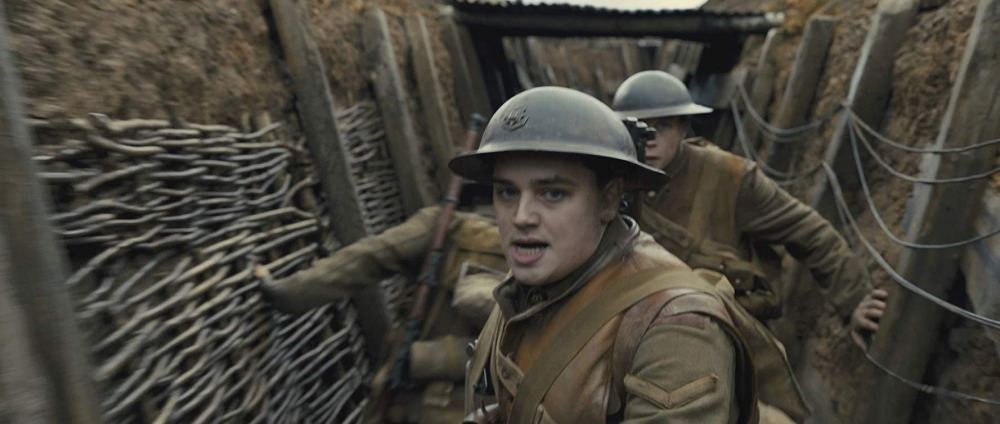
The Marvel comic book characters Black Tom Cassidy and the Vulture, Adrian Toomes, are two examples of this name usage in JEM, both appearing from Jewish creators Christ Claremont and Stan Lee respectively. The surname Toomes is a form of Thomas. In fact Adrian may also mean “black” so the names are nearly identical in meaning to Tom Blake appearing in 1917, if we take Blake to mean “black.” The clear Christ figure in the Matrix series, Neo or Thomas Anderson, may be another example. There the last name Anderson appears to be a reference to “Son of Man.” The temperaments of Joe Blake and Tom Blake in the film also corroborate the first as Aryan and the second as Jewish. Whereas Joe is martial and authoritative, Tom is gentle and meek.
In the context of 1917, this name Tom becomes especially apropos because Tom dies, while, truly, his spirit lives on. Hence the name becomes a reference to a Jewish Dying-and-Rising God. This study contends that Dying-and-Rising Gods, originating in Mesopotamia, such as Dumuzid, Tammuz and Adonis, are fundamentally Semitic and may represent the cycle of expulsion/crypsis and return common to the Jewish or proto-Jewish life/survival pattern. In any case, news of Tom’s death delivered to Joe by a man named Schofield becomes especially a reference to Christianity. Again, Will Schofield is almost certainly a reference to the Scofield Reference Bible.
Indeed, Will’s name is really something. While the full name William may not have any special ethnic significance in naming convention, the shortened form Will may. And that this character goes by the shortened Will is made clear, in dialog, at the end of the film when he finally introduces himself to Joe.
The name Will is, in the context of this film, possibly a reference to Yahweh, a name that means “I am.” In other words, the game being played here is that the name Will is a reference to the word “will” and not the name William. “Will” is defined as: “1. am (is, are, etc.) about or going to (i.e. I will be there tomorrow. She will see you at dinner) 2. am (is, are, etc.) disposed or willing to (i.e. People will do right) 3. am (is, are, etc.) expected or required to:” etc. The relatively obscure comic book character Will Magnus, a clear Jewish figure developed by Jewish Esotericist Robert Kanigher, is another example where the same name meaning appears intended.
1917 may even esoterically depict the Judaizing of Will Schofield or of Schofield’s line. Importantly, at the beginning of the film, the Jewish Christ figure Tom Blake “chooses” Will Schofield to accompany him on his mission. This detail is emphasized in the film in a scene where Will dramatically complains of his selection by Tom. “Why in God’s name did you have to choose me?!” He exclaims.
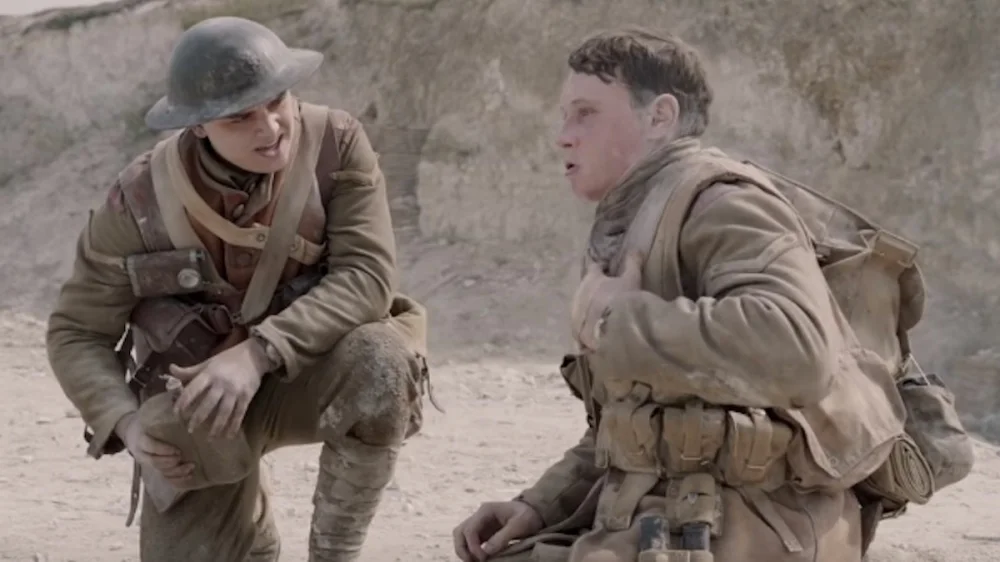
Earlier Will is rescued by the Christ-figure Tom Blake in a critical scene in the film. After a rat sets off an armed trip wire in a German bunker, Will is buried by rocks, which, this study argues, are a Jewish symbol referencing the Jewish God. Tom unearths him. Yet Will is made temporarily blind by the rock dust and must be led out of the cave by his savior Tom.
Blindness is a reoccurring motif in JEM appearing saliently in Paul’s conversion to Christ. It appears to be a reference to Jewish Religious, Symbolic and Cultural deception. Famously, Paul’s conversion story sees the apostle going blind for three days after a visit from Christ until finally “something like scales fell from his eyes.” (Acts 9:18)
Indeed, the German bunker itself maybe a reference to tombs and caves appearing in JEM throughout history, whether Christ’s tomb, from which Christ reappears resurrected, or King David’s cave, whereby David escapes the Aryan Saul. Caves and tombs are, this study argues, womb symbols or vaginal in significance. The symbol of the cave or tomb is discussed in this article.
A curious moment when Tom sits on a cot in the bunker and rocks on it saying “Sco, how about this?” as if, perhaps, to invite Will onto the cot, maybe suggestive of intimacy. Regardless, does Will’s name suggest that the episode signals his or his line’s rebirth as a Jew? It should be mentioned as well while Tom leads Will out of the Bunker he also leads him into it saying “there is probably a way through.”
Does Tom, entering the German Bunker with Will, again a vaginal symbol, suggest him also as Will’s father? Spiritually, of course, Tom becomes this, with Will his messenger. In fact, we might regard Will as the resurrected form of Tom/Christ. But there may also be a reference here to Jewish Bride Gathering and the admixing of blood. Hence, that it is a “German bunker,” from which an Ashkenazi type would emerge, might be meaningful here.
But of course this possible meaning for the name Will is corroborated by Will’s last name, which is, for our purposes, far more significant. The surname Schofield is, of course, merely a variant spelling of Scofield. Indeed, his last name is almost certainly a reference to the Scofield Reference Bible, a Bible that extorts Gentiles especially to protect the interests of Israel and Zionism as is well known in these parts of the web.
This becomes especially obvious because the name of the film itself is a reference to the publishing of the Scofield Reference Bible, which first appeared in 1909 yet reappeared, revised by the author, in 1917. In fact, it is commonly called the “1917 Scofield Reference Bible.” Indeed, the apocalyptic carnage of World War I, occurring in the intervening years, was popularly seen as vindicating the dispensationalist scheme in the Scofield Bible.[2]
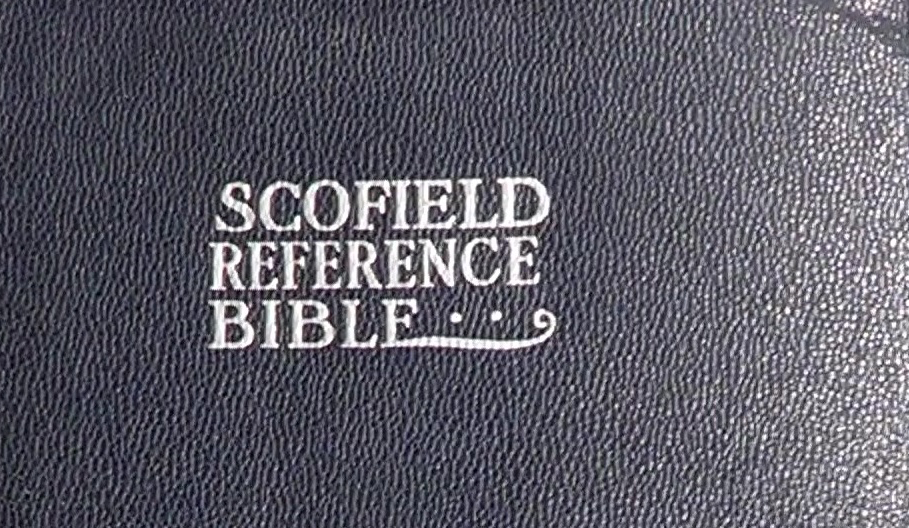
After World War I, the Scofield Reference Bible flew off the rack, exceeding two million copies by the end of World War II.[3] Hence the pointless carnage of the World Wars literally sold the Scofield Bible and its apocalyptic pro-Israel message. In other words, evidently the film 1917 itself serves as an esoteric celebration of the Scofield Bible, the carnage of the World Wars and the Christian Zionism it would birth. The reader should consider this carefully. Here we find a film made by an ostensibly enlightened, liberal Hollywood Jew, esoterically endorsing apocalyptic Christian Zionism. This is what we call the Caducean.
When Will finally reaches Joe Blake, Joe is stricken by the news of the death of Tom (Christ). Joe will doubtlessly remain fiercely loyal to the notion that Tom was “a good man” as Will, a symbol representing the Scofield Reference Bible, reports. Will tells Joe as well that Tom “was always telling funny stories” and “saved his life.” Christ was also a teller of parables. When one begins to understand the Christ story as one laden with JEM and cynically peddled to non-Jews, he also understands his parables as “funny” from a mischievous Jewish perspective. Regardless, it is clear Joe will become loyal to the memory of the Jewish God that Tom represents, Christ. Hence Will has accomplished his task.
Importantly, at Tom’s request, Will insists on writing the account of Tom’s death to the mother of the Blake sons. Hence Will Schofield controls the message. The significance of Tom or Christ, and his life, will be controlled by Schofield or, of course, the Scofield Reference Bible. The end of the film sees Will wandering toward a lone tree set strikingly against the horizon. This study discusses arboreal symbols as references to Aryans. Hence the suggestion is that Jews retain genetic access to Aryans, their Garden of Eden and Tree of Life. Though one layer up, this becomes a simple reference to the founding of the modern state of Israel or the New Jerusalem of the Book of Revelation.

The viewer of the film may argue that the war is explicitly an anti-war film as it shows the horrors of war and the hero’s mission is preventing the loss of more lives by averting a pointless attack on an enemy position. On an exoteric level this is true. The film though does gloatingly suggest the Aryan as a sacrificial offering in war. In this case, they are understood especially as a sacrifice made to establish the modern state of Israel.
This suggestion is especially made by Will’s late delivery of the message to call off the attacks. The Devonshire Regiment plans to attack in two waves. Will arrives in time to protect the lives of the second wave. Joe Blake is part of the first wave but miraculous survives the attack.
The first wave/second wave distinction seems likely to be a reference to the firstborn/second born distinction particularly as we understand Joe Blake to have been in the first wave. Hence while the second wave, metaphorically representing Jews, is saved, the first wave is sacrificed. Exodus 13:2 describes how the firstborn are to be a sacrifice to Yahweh. There it says: “Consecrate to Me every firstborn male. The firstborn from every womb among the Israelites belongs to Me, both of man and beast.”
Will is delayed in his transmission of the message that would have saved the first wave because he is knocked unconscious during a gun fight with a German solider. Pinned down in an exterior stone stairwell in Écoust-Saint-Mein by a German rifleman, Will returns fire and injures the German, perhaps mortally. Indeed, the German’s gunfire ceases. Nevertheless, rather than resuming with his mission, Will insists on entering the building where the German is holed up to finish the German off. Speculatively he’s seeking to avenge the inexplicable murder of the Christ-figure Tom.
It’s during this final, arguably gratuitous exchange with the German that Will is knocked unconscious, delayed in his mission and prevented from saving the first wave. That a significant amount of time has passed is made evident by the conspicuously long cut to black that follows and the fact that Will wakes up in the evening after having been knocked out during the day. Likewise, it’s the only break in an otherwise seemingly unbroken shot that uniquely characterizes the film.
Meaningfully, when Will awakens, the town of Écoust-Saint-Mein is ablaze. One striking and memorable shot sees him enter a town square before a large central building now an inferno. Given the other contextual clues in the film, this is likely a reference to Yahweh as a consuming fire God, one understood in the Hebrew Bible as consuming burnt offerings.
This study argues that those burnt offerings represent Aryans or non-Jews as consumable human resources, whether represented as livestock, grain, incense or sheaves of wood. This linked article is just one place where this reoccurring motif is discussed. This is another place. In the context of the film, this inferno may suggest the sacrifice of the first wave of the Devonshire Regiment.
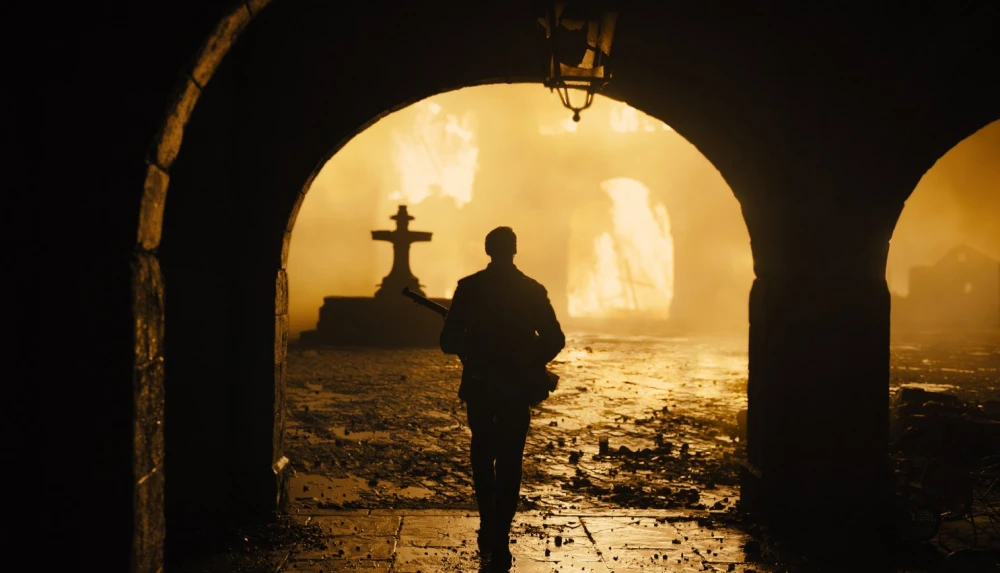
[1] Song of Solomon 1:5 “I am black, yet lovely, O daughters of Jerusalem, like the tents of Kedar, like the curtains of Solomon. Do not stare because I am black, for the sun has gazed upon me.” Christians commonly assert this is a description of the woman and not the man (presumed to be Yahweh) in the poem. However no evidence suggests this. Though it is clear that the poem is a dialog between lovers, speakers are not identified from this passage to that. While scholars are able to reach consensus on later passages of the poem as to which speaker is speaking, 1:1–6 is commonly classed “introduction” while 1:17 -2:7 simply Dialogue between lovers. The speaker is addressing the daughters of Jerusalem. Perhaps this suggests a male perspective particularly in the context of a love poem where the male is understood a courter. Likewise 1:6 indicates the speaker a vintner, a male profession in the ancient world, arguably equating him the Semitic Bacchus as was Yahweh by ancient mythographers. Elsewhere in the poem the female, possessing breasts or “shad,” שַׁד, is praised as “fair” or Japheth such as in 4:1. There experts are in agreement, the man is addressing the “Japheth” women. All of this, of course, is weighed against a consistent self-perception appearing in Jewish Esoteric Moralization, where Jews commonly feel themselves to be the darker man vying for fairer stocks.
[2] “At the popular level, especially, many people came to regard the dispensationalist scheme as completely vindicated.” Mangum & Sweetnam, 179
[3] Gaebelein, 11
Brilliant. Will buy your book as soon as it comes out
LikeLiked by 1 person
Thank you man! Appreciate your support.
LikeLike
Song of Solomon 1:5 is the woman speaking, not the male lover.
It was used incorrectly in another article too, can’t remember which.
https://www.biblegateway.com/passage/?search=Song+of+Solomon+1&version=ESV
LikeLike
Thanks for your comment. Actually speakers are not specified and who is speaking is the function of guesswork. This is the general consensus as described @ Wiki:
There is widespread consensus that, although the book has no plot, it does have what can be called a framework, as indicated by the links between its beginning and end.[7] Beyond this, however, there appears to be little agreement: attempts to find a chiastic structure have not been compelling, and attempts to analyse it into units have used differing methods and arrived at differing results.[8] The following schema, from Kugler & al.[9] must therefore be taken as indicative, rather than determinative:
Introduction (1:1–6)
Dialogue between the lovers (1:7–2:7)
The woman recalls a visit from her lover (2:8–17)
The woman addresses the daughters of Zion (3:1–5)
Sighting a royal wedding procession (3:6–11)
The man describes his lover’s beauty (4:1–5:1)
The woman addresses the daughters of Jerusalem (5:2–6:4)
The man describes his lover, who visits him (6:5–12)
Observers describe the woman’s beauty (6:13–8:4)
Appendix (8:5–14)
Since she is described as Japheth (“Fair” ostensibly European) and from Lebanon (possibly a reference to Laban, white) elsewhere and since she is working in a vineyard (likely a male profession) my interpretation seems most likely. I understand that Christians commonly believe otherwise. Though obv. I depart from them on many things. But I will make sure that this point (ostensibly my interpretation) is clarified.
LikeLike